The California Poppy (Eschscholzia californica) was selected as the State flower by the California State Floral Society, in December 1890. Other native flowers under consideration at the time were the Mariposa Lily (Calochortus), and Matilija Poppy (Romneya). The California Poppy though won the vote by a landslide. Eventually, in 1903, the California state legislature officially declared Eschscholzia californica as the State flower, and April 6th is designated as the official California Poppy Day.
California poppies are native to the west coast of North America, ranging from western Oregon to Baja California, and found in many open woodland, chaparral, foothill and grassland communities below 6,500 feet in elevation.
The genus, Eschscholzia, is named after an Estonian botanist Dr. Johann Friedrich Gustav von Eschscholtz (1793-1831) who was a surgeon and naturalist on Russian expeditions to the Pacific Coast of North America in 1816 and 1824.
There is some debate as to the number of native subspecies, but at least some taxonomists seem to accept that there are two primary subspecies, E. californica californica, consisting of four varieties (including the yellow and orange bi-color coastal form E. californica californica var. maritima that is commonly seen here along the Central Coast), and the yellow subspecies, E. californica mexicana, or Mexican Goldpoppy, of the Sonoran Desert. Numerous hybrid cultivars have also been produced by horticulturists in a wide range of colors and habits.
The varieties within the E. Californica californica subspecies show various subtle differences in color and habit. Along the coast, from the San Francisco peninsula northward, E. californica californica var. californica tends to grow more prostrate and has predominantly yellow flowers. In inland non-arid regions the orange flowered perennial form E. californica californica var. crocea predominates, and is taller in habit than E. California californica var. peninsularis which is found in more arid environments, and grows as an annual. When planting California Poppies within the State, it is recommended that the variety native to your region be sown.
Although Eschscholzia californica is native to western North America, it has reportedly naturalized in many parts of the world, including India, Chile, Argentina, Australia, and South Africa, and is even considered an invasive plant in some parts of the United States outside of its home range.
This year we only have a few California Poppies blooming here, in part because our gophers and deer seem to destroy them faster than they can grow or set seed.
In late winter to early spring, the leaves begin to emerge and are blue-green in color, and deeply dissected, growing from the base of the plant.
Flowers are borne on single stalks, appearing between February to September, with the heaviest bloom period through May.
At the base of the flower is the receptacle. This is a distinctive expanded rim that is most readily visible when the flowers are still in bud.
Above the receptacle there are two green fused sepals that enclose the flower bud. As the bud swells, and the petals unfurl, the sepals fall away.
The flower opens to reveal four overlapping yellow to orange petals forming the cup-shaped flower. The early Spanish explorers would call California Poppies copa de oro meaning ‘cup of gold’.
In the very center there are numerous stamens and two fused carpels.
The flowers are sunlight responsive, closing before sunset, and remain closed on overcast days.
After the flowers fade, 3-9 cm long seed pods are formed, containing 1.5-2 mm brown to black seeds, which are scattered in all directions when the pods open with explosive force. However, as the deer devoured these flowers shortly after they bloomed, I have no seed pods to show you, but the botanical print below illustrates them well.
The dehiscent nature of the seed pods means that timing is critical for collecting seeds from plants in the garden. Last year, as the pods turned brown, but before they split open, I simply placed the pods in a closed paper bag, so as the pods shattered, the seed was captured. The seed can then be sown, ideally in the fall, just before the winter rains return for bloom the following spring.
California Poppy flowers historically were predominantly pollinated by beetles, but now are visited regularly by European honey bees (Apis mellifera).
There are many documented uses of California Poppies by Native Americans. The Costanoans used a decoction of the flowers in their hair to kill lice, and they also laid flowers under the beds of children to aid their sleep. The Mendocino Indians used the juice of the roots as a wash for skins sores, and also consumed the juice for use as an emetic, or as a treatment for tuberculosis. Small pieces of root would be placed within a tooth cavity to treat a toothache. A number of tribes boiled or roasted the leaves as greens, including the Luiseno, and Neeshenam. The Cahuilla women reportedly used the pollen as a facial cosmetic. [1]
——————-
[1] Daniel E. Moerman’s Native American Ethnobotanical Database

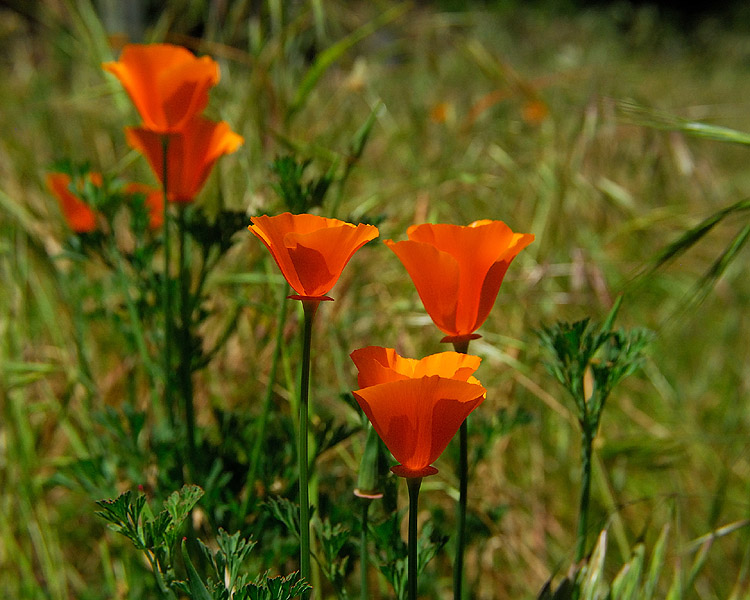
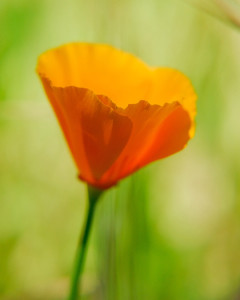
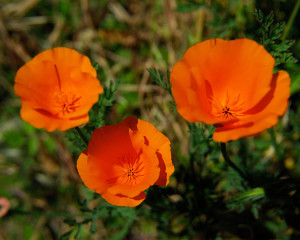


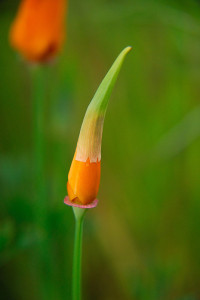


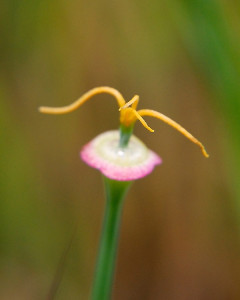

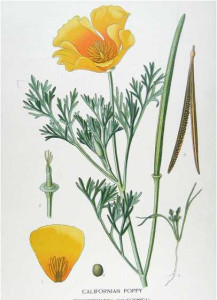
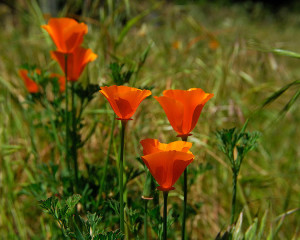







I love Matilja Poppies. They look like giant fried eggs! California poppies have naturalized in our yard and I’m not sure if I’m happy about that or not. For now, I’ll leave them, unless they are in a veggie bed. I wish I could post a photo I took of poppies and goldfields near the Tehachapi Mountains during our last big El Nino. It’s breathtaking.
.-= Dog Island Farm´s last blog ..Monday’s Guests – Curds + Whey = Cheese =-.
I bet that looked fabulous. With the rains this year, I’m impressed at what’s even growing locally. Someday though, I need to make the effort to get down to Antelope Valley when the hills are ablaze there too. Maybe next spring if we’re blessed with another normal rainfall winter!
So great to learn more about this classic! I can never resist pulling off it’s “cap” when it’s ready to open it’s silky petals.
While I love Romneya coulteri more, I’m glad they didn’t choose an invasive plant as the state flower!
.-= Christine´s last blog ..What’s For Dinner? Aphids? Again?! =-.
It is so hard to resist pulling off those little hats. I admit…I even did it once myself this spring, as I hadn’t before 😛
As a native Californian, this is my favorite wildflower and I always grow some in my garden each spring. I definitely prefer it to the Mexican species that dots the desert southwest in spring time.
.-= Noelle / azplantlady´s last blog ..An Orange Monday Morning…. =-.
That colour – wow, I have always loved Californian poppies. After seeing your post it has reminded me just how much. Green was my favourite colour up to now, but between me and you, orange is now my new green!
.-= Ena Ronayne´s last blog ..Show Gardens Bloom 2010 – Counting Down =-.
I used to be scared of bright colors in the garden, but recently, oranges…and purples, just make me happy! The reality is, there’s not much that is white or pink in the native flower palette…at least it seems that way. Here so many of the natives seem so much more vibrant. I’m looking forward to adding a lot of color in the coming years here!
I see lots of California poppies blooming around here, often on the sides of the freeway where I think people have sown wildflower seeds. They always remind me of when I was little and we lived in Southern California. I love their bright orange colors and have noticed they seem to open with the sun.
.-= Catherine´s last blog ..Ladybugs on the loose. =-.
I saw these when I visited my son in Oregon! This flower has such a happy color. Beautiful! Sadly, there is no hope to grow them in my area, but I enjoyed this post.
.-= debsgarden´s last blog ..Summer is Here! =-.
I used to grow these when I was in Ireland – they are summer annuals that we sow around April May time. I had a wonderful drift of them one year. I’ve tried to grow them in this garden but have not been as successful. But I would love to try again in a different area after reading this. Thanks Clare for a great informative piece. 🙂 Rosie
I do love the California Poppies, mainly because the insects also love them. I do prefer the pink and cream shades though…
I’ve a few growing at the moment in my new border, so hope to see their sunny faces soon enough 🙂
I’m amazed these can grow in Ireland. When mine get too much water, they get leggy and floppy, and lose all their structure.
.-= lisa´s last blog ..A Hive of Activity =-.
In gardens in Belgium, you sometimes find those poppies, and the seeds are often included in annual seed-mixtures for flower fields.
They are far from invasive here, and although I prefer natives in my garden, I have no problems with non-invasie ‘aliens’ that have a rather wild appearance.
The Californian poppy is called ‘slaapmutsje’ (small nightcap) in Dutch, refering to the shape of the bud.
.-= AnneTanne´s last blog ..Rabarbercrumble – Rhubarb crumble =-.
As a native Californian I feel compelled to grow these even though I have been living in Massachusetts for over 20 years. Mine take a while longer to come up than in warmer places, but the bright orange flowers and gray-green foliage are nice additions to the garden. Thanks for sharing the details on this beautiful plant.
.-= Curtis´s last blog ..American Bellflower =-.
I love this poppy, Clare, a great choice for a state flower. My iceland and Oriental poppies are now in bloom … luv it! An informative post … great photos!
.-= joey´s last blog ..MONDAY MUSING ~ MAY MINI- GARDEN TOUR =-.
Yay! I love these. They are sooo pretty in all of their stages! I got a free seed packet and am waiting for the flowers as we speak. They are already open on the road sides here in Oregon.
.-= Lauren Drury´s last blog ..Garden Second Planting. =-.
Clare, great post! Poppies are indeed quintessentially Californian. As you mentioned, large expanses can be seen in the Antelope Valley in good rainfall years. In my area, the Elsinore hills are also typically awash in orange during the spring, but for some odd reason this year, there was nary a single bloom. We did have El Nino, but I guess moisture must still work in tandem with optimal temperatures in order to trigger bloom. Again, thanks for sharing this wealth of information on our native poppy!
.-= Camissonia´s last blog ..Crazy Rainstorm this Morning =-.
wow. that’s a lot of information about one of my favorite flowers. i was surprised the first time the deer ate poppies that i’d planted. they don’t get eaten in some gardens, so it seems like a gauge for a neighborhood, a way to guess how much deer browsing there is. too bad the deer eat so many of yours.
.-= ryan´s last blog ..The Native Strawberries =-.
When I first saw the title of the post I thought it was not going to be very interesting. I mean there are poppies all over the place here. But then your post took me by surprise. Very informative and well written (as always). Thanks for this post.
.-= Brad´s last blog ..Stop – Don’t do this! Invasives =-.
My daughter grew some of these from seeds last year and they were lovely. I’ve had them self sow over a couple of years in the garden, but they don’t ever seem to get too well settled or reach the point of becoming invasive. It’s kind of nice to think we can grow something that is native to your part of the world 🙂
.-= Heidi (GippyGardener)´s last blog ..Rose Diary / Survey Day – Late Autumn Tough Guys =-.
Oh, how I love Califoronia poppies! I remember hiking along the coast with the poppies in their full glory. The orange set against the blue of the Pacific truly vibrated. Maine is not so kind to them, but still I try…
Thanks for sharing so much great information!
Clare, thank you for introducing me (officially) to the California poppy. I did not know much about them at all — well, other than that they are pretty to look at. 🙂
I love how silky the petals looked when you got that shot just before dark, and of course the elfin sepal cap is just too adorable, inspiring all sorts of faerie fantasy imaginings. And I can add another now to my list of beetle-pollinated plants.
Your deer are really annoying. How dare they eat all the blooms!
.-= Meredith´s last blog ..star stuff =-.
I enjoyed reading all your poppy information. I guess that a plant that’s so loved (in California at least) will have a lot of stories and information associated with it. I read somewhere that at one point the single main species was considered to be many dozen different species based on some of the differences you mention. Besides, who wouldn’t want this plant named after themselves?
.-= lostlandscape (James)´s last blog ..some local yellow daisies =-.
I just love when they have their little pointy hats! I think I have the non-local kind here from before I was aware there was a difference, and they reseed sporadically and not too much though this year they’re doing well. I don’t know where you can get the local seed though – will have to find out.
.-= Country Mouse´s last blog ..Hairy Honeysuckle – Propagation of Lonicera Hispidula var. vacillans =-.